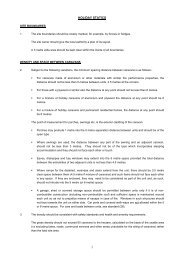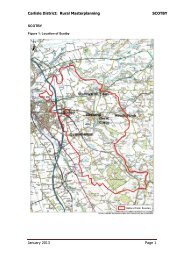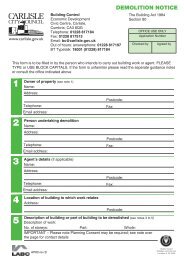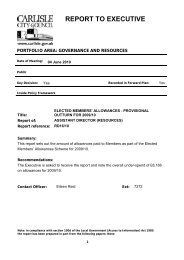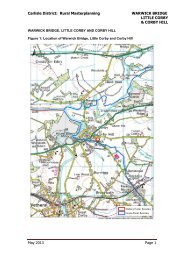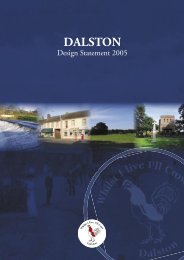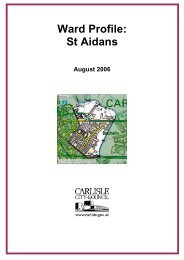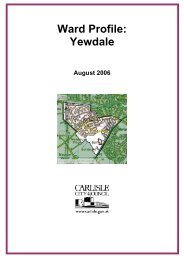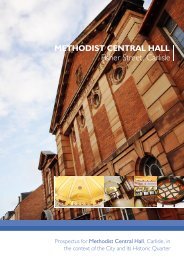Carlisle District Local Plan.indd - Carlisle City Council
Carlisle District Local Plan.indd - Carlisle City Council
Carlisle District Local Plan.indd - Carlisle City Council
You also want an ePaper? Increase the reach of your titles
YUMPU automatically turns print PDFs into web optimized ePapers that Google loves.
<strong>Carlisle</strong> <strong>District</strong> <strong>Local</strong> <strong>Plan</strong> 2001 - 2016 Revised Redeposit draftdifferent habitats. Visually, trees are attractive in their own right, and also as part of thewider landscape. They are also important to the local climate, and reduce pollution byabsorbing carbon dioxide and producing oxygen.3.10 On development sites there will be a presumption in favour of retaining existing trees wherethey contribute to amenity, and are healthy. Existing trees provide a mature landscapesetting for new development and help to integrate new development into the surroundingenvironment, whether urban or rural.3.11 This policy should be read in conjunction with the adopted Supplementary <strong>Plan</strong>ningGuidance note, ‘Trees on Development Sites’, which gives detailed advice on all aspectsof integrating trees with new development. In particular, it sets out measures to be taken toensure the protection of trees during development.3.12 Tree preservation orders will be used to protect selected trees and woodlands if theirremoval would have a significant impact on the local environment and its enjoyment by thepublic. In order to assess amenity, the following key factors will be taken into account:1. visibility - the extent to which the trees and woodlands can be seen by the generalpublic;2. individual impact - an assessment of the size and form of the tree, its future amenityvalue, its rarity, value as a screen or contribution to a conservation area;3. wider impact - the significance of the trees in the local surroundings, taking intoaccount how suitable they are to their particular setting as well of the presence ofother trees nearby.POLICY CP3 Agricultural LandPermission will not be given for development where it would lead to the loss of the bestand most versatile agricultural land, unless:1. there is an overriding need for the development; and2. there is insufficient land of a lower grade available; or3. available lower grade land has a statutory landscape, wildlife, historic orarchaeological designation.3.13 The majority of the countryside in the <strong>District</strong> is in active agricultural use, although there arelarge tracts of commercial forestry in the north of the <strong>Plan</strong> area. Changes in agriculturalpractices and payments brought about by the European Common Agricultural Policy, andthe effects of the foot and mouth outbreak in 2001, are leading to a growth in economicdiversification schemes relating to farms. Proposals range from farm shops and bed andbreakfast enterprises to larger recreational pursuits.3.14 The <strong>City</strong> <strong>Council</strong> considers that it is important to encourage the process of diversificationin the rural economy, whilst at the same time protecting the landscape for the benefit andenjoyment of the whole rural community and visitors. The draft Soil Strategy for Englandstates that if agricultural land is used for development, and semi natural land reclaimedfor agriculture, this could have adverse implications for diversity and quality of soils. It isimportant to protect enough of the right types of soils from development so that we canmeet present and future needs for food and forestry production, ecological habitats andbiodiversity, and the protection of our cultural heritage.September 2006 31



